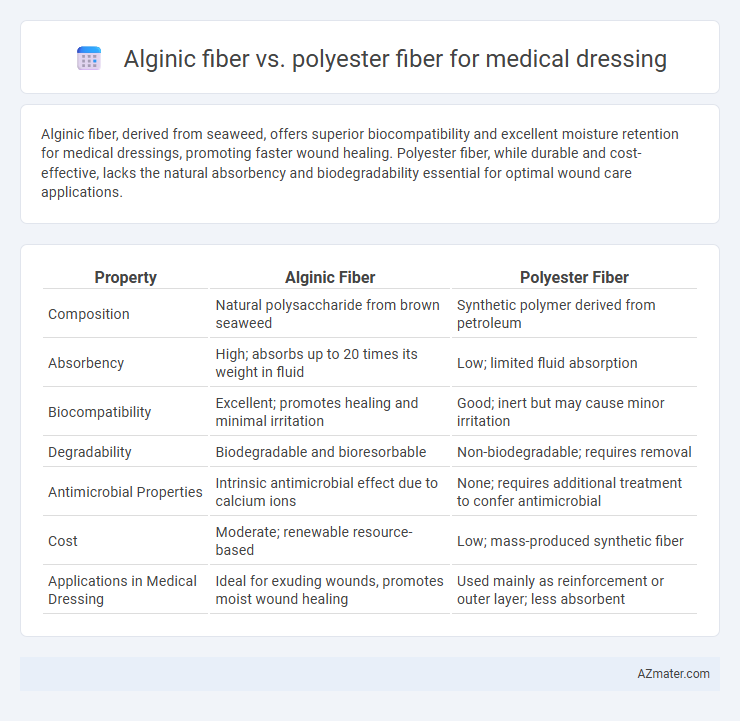Alginic fiber, derived from seaweed, offers superior biocompatibility and excellent moisture retention for medical dressings, promoting faster wound healing. Polyester fiber, while durable and cost-effective, lacks the natural absorbency and biodegradability essential for optimal wound care applications.
Table of Comparison
| Property | Alginic Fiber | Polyester Fiber |
|---|---|---|
| Composition | Natural polysaccharide from brown seaweed | Synthetic polymer derived from petroleum |
| Absorbency | High; absorbs up to 20 times its weight in fluid | Low; limited fluid absorption |
| Biocompatibility | Excellent; promotes healing and minimal irritation | Good; inert but may cause minor irritation |
| Degradability | Biodegradable and bioresorbable | Non-biodegradable; requires removal |
| Antimicrobial Properties | Intrinsic antimicrobial effect due to calcium ions | None; requires additional treatment to confer antimicrobial |
| Cost | Moderate; renewable resource-based | Low; mass-produced synthetic fiber |
| Applications in Medical Dressing | Ideal for exuding wounds, promotes moist wound healing | Used mainly as reinforcement or outer layer; less absorbent |
Introduction to Alginic and Polyester Fibers in Medical Dressings
Alginic fibers, derived from brown seaweed, are hydrophilic and highly absorbent, making them ideal for wound dressings that manage exudate and maintain a moist healing environment. Polyester fibers, synthetic and durable, offer excellent tensile strength and resistance to microbial growth, often used in medical dressings requiring structural support and prolonged wear. The choice between alginic and polyester fibers hinges on wound type, absorption needs, and desired healing conditions.
Chemical Composition and Source
Alginic fiber is derived from alginate, a natural polysaccharide extracted predominantly from brown seaweed, making it biocompatible and highly absorbent, ideal for wound dressings. Polyester fiber, a synthetic polymer composed of polyethylene terephthalate (PET), offers strength and durability but lacks inherent bioactivity and moisture management found in alginic fibers. The chemical composition of alginic fiber promotes gel formation upon contact with wound exudate, enhancing healing, whereas polyester fibers mainly provide structural support without chemical interaction with the wound environment.
Absorbency and Fluid Management
Alginic fiber offers superior absorbency and excellent fluid retention due to its natural hydrophilic properties, making it highly effective for managing moderate to heavy wound exudate in medical dressings. Polyester fiber, while less absorbent, provides durability and moisture vapor permeability that helps maintain a balanced moist wound environment. The combination of alginic fiber's gel-forming capability with polyester's structural support enhances overall fluid management, promoting faster wound healing and reduced maceration risk.
Biocompatibility and Patient Comfort
Alginic fiber exhibits high biocompatibility due to its natural origin, promoting effective wound healing and minimizing allergic reactions in medical dressings. In contrast, polyester fiber, being synthetic, may induce irritation or discomfort in sensitive patients but offers superior durability and moisture management. Patient comfort is enhanced by alginic fiber's ability to maintain a moist environment that supports tissue regeneration, whereas polyester dressings often require additional layers to achieve comparable breathability and softness.
Antimicrobial Properties
Alginic fiber exhibits inherent antimicrobial properties due to its natural composition derived from brown seaweed, promoting wound healing by maintaining a moist environment and inhibiting bacterial growth. Polyester fiber, while strong and durable, lacks intrinsic antimicrobial activity and often requires treatment with antimicrobial agents to prevent infection in medical dressings. The biocompatibility and biodegradability of alginic fiber make it a superior choice for antimicrobial medical dressings compared to synthetic polyester fibers.
Wound Healing Performance
Alginic fiber, derived from seaweed, offers superior wound healing performance due to its high absorbency, biocompatibility, and ability to maintain a moist wound environment, which promotes faster tissue regeneration. Polyester fiber, while durable and cost-effective, lacks inherent bioactivity and moisture retention, often requiring additional treatments to support optimal healing. Clinical studies emphasize alginic dressings as more effective in managing exudate and reducing infection risk compared to polyester-based materials.
Mechanical Strength and Durability
Alginic fiber exhibits excellent mechanical strength due to its natural gel-forming properties, which provide effective wound protection while allowing flexibility and absorption. Polyester fiber offers superior durability and tensile strength, making it resistant to wear, stretching, and repeated sterilization processes in medical dressing applications. The choice between alginic and polyester fibers depends on balancing bio-compatibility and biodegradability with long-term mechanical performance in wound management.
Biodegradability and Environmental Impact
Alginic fiber, derived from natural seaweed, offers excellent biodegradability, breaking down efficiently in natural environments and reducing long-term environmental impact in medical dressings. Polyester fiber, a synthetic polymer, resists biodegradation, leading to persistent environmental waste and greater ecological concerns. The ecological advantage of alginic fiber makes it a preferable choice for sustainable medical dressings focused on minimizing pollution.
Cost-Effectiveness in Healthcare Settings
Alginic fiber dressings, derived from seaweed, offer superior biocompatibility and promote faster wound healing but tend to be more expensive than polyester fiber dressings. Polyester fiber dressings, while less costly, may not provide the same level of moisture retention and antimicrobial benefits critical for advanced wound care. In healthcare settings, the initial higher cost of alginic fiber can be offset by reduced healing times, lower infection rates, and decreased overall treatment expenses, making it a cost-effective choice for complex wounds.
Clinical Applications and Recommendations
Alginic fiber, derived from seaweed, excels in medical dressings by promoting hemostasis and maintaining a moist wound environment critical for healing chronic wounds and pressure ulcers. Polyester fiber, known for its durability and moisture resistance, is recommended in dressings requiring enhanced tensile strength and structural support in post-surgical wounds. Clinical applications favor alginate dressings for their bioabsorbable and highly absorbent properties, while polyester fibers are preferred for long-term wound coverage and integration into composite dressing systems.

Infographic: Alginic fiber vs Polyester fiber for Medical dressing
 azmater.com
azmater.com